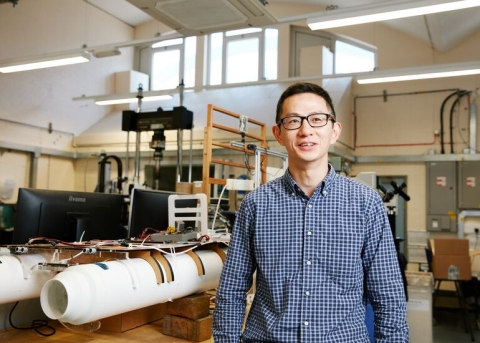

Dr Ya Huang
Biography
Ya is an associate professor (reader) of Human Motion Dynamics. He specialises in human responses to motion and signal processing. Ya joined Portsmouth in 2009. Before that, he worked as a post-doctorate researcher on high strain rate collapse of steel framed structures at the Blast and Impact Dynamics Group at the University of Sheffield. His doctorate training in human responses to whole-body vibration concluded in 2008 at the Institute of Sound and Vibration Research (ISVR), University of Southampton.
Research interests
Through understanding force and motion experienced by the human body i.e. biomechanics, Dr Huang’s research interest has been to apply analytical and computational methods to understand human responses to whole-body vibration and repeated shocks experienced in different modes of transport on land, in the air and at sea. He has over 20-year research experience in the laboratory and in the field.
Dr Huang has contributed to new methodologies to reconstruct multi-channel nonlinear and cross-correlated force and motion signals during whole-body vibration. They serves as a key step for modelling ride quality and injury prevention on different transport platforms. These outcomes reduce the computational costs and enhance motion transmission models leading to better design and assessment approaches. He has led experimental studies of crew dynamic sitting and bracing strategies on fast lifeboats funded by the Royal National Lifeboat Institution (RNLI) in the UK.
Ya leads a new research to advance visual computing algorithms to quantify fast vessel seakeeping performances via a) 4D ocean wave reconstruction using stereo vision, b) vessel hydrodynamics and c) human biomechanics. These have been realised by his recent investigations from musculoskeletal modelling of lifeboat crew for optimal bracing, and modification of wave stereo vision systems, to the complete rebuilding and adaption of classic boundary element method to interpret hydrodynamic loading on the vessel and then the crew. Funded by the EPSRC (EP/X035778/1), this new research aims to develop computationally fast algorithms to predict vessel seakeeping performances in real-time, enhancing maritime safety and enabling next generation human-centred autonomy of marine transports.
Research outputs
2024
Transmission of fore-and-aft floor vibration to the spine and head of standing people
Nawayseh, N. K. H., Arumugam, A., Huang, Y.
13 Feb 2024, In: International Journal of Occupational Safety and Ergonomics
Research output: Article
2023
Enhanced vibration damping and viscoelastic properties of flax/epoxy composites and their carbon fibre hybrid laminates
Dashatan, S. H., Sit, M., Zhang, Z., Grossmann, E., Millot, J., Huang, Y., Dhakal, H. N.
1 Dec 2023, In: Composites Part A: Applied Science and Manufacturing. 175, 9p., 107819
Research output: Article
A note on random ocean wave characterisation
Bucchi, A., Huang, Y.
12 Sep 2023,
Research output: Conference contribution
Froude-Krylov force estimation and waypoint tracking control of an underactuated model boat
Huang, Y., Bucchi, A.
12 Sep 2023,
Research output: Conference contribution
2021
Observer-based fixed-time continuous nonsingular terminal sliding mode control of quadrotor aircraft under uncertainties and disturbances for robust trajectory tracking: theory and experiment
Mecali, O., Xu, L., Huang, Y., Shi, M., Xie, X.
1 Jun 2021, In: Control Engineering Practice. 111, 104806
Research output: Article
Effect of damping on waypoint tracking control of an underactuated small robotic boat
Huang, Y., Yu, H.
1 Jun 2021, In: International Journal of Intelligent Control and Systems. 1, 2, p. 10-18, 8p.
Research output: Article
Synchronization and calibration of a stereo vision system
Huang, Y.
9 Apr 2021,
Research output: Conference contribution
Hydrodynamic simulation of frontal plane deck motion during a mechanical shock on a lifeboat
Thiele, J., Huang, Y., Knight, J.
9 Apr 2021,
Research output: Conference contribution
A simulation study of simple local path planning and control for unmanned surface vehicles
Stergianelis, D., McConnell, M. R., Ji, Z., Huang, Y., Yu, H.
9 Apr 2021,
Research output: Conference contribution
Principal component analysis of the cross-axis apparent mass nonlinearity during whole-body vibration
Huang, Y., Ferguson, N.
1 Jan 2021, In: Mechanical Systems and Signal Processing. 146, 13p., 107008
Research output: Article
